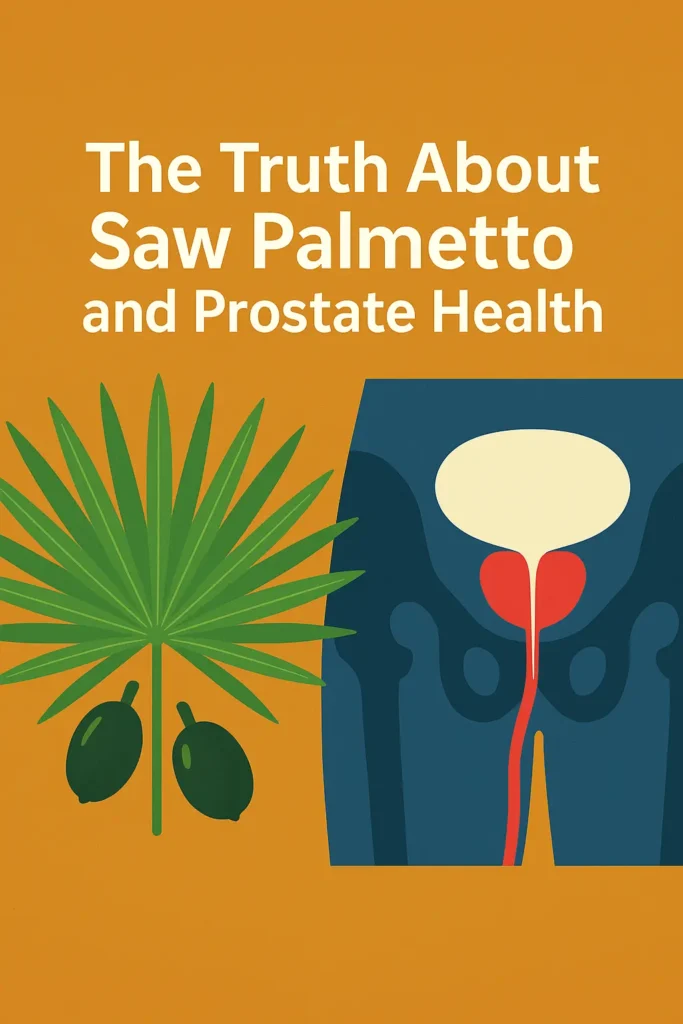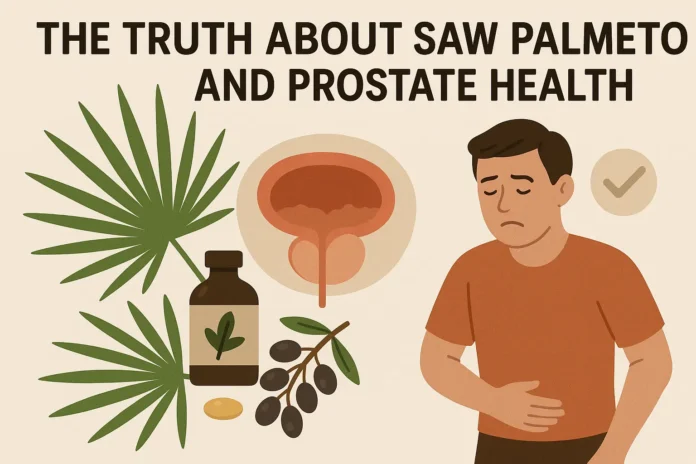- Is This Popular Supplement Really the Solution for an Enlarged Prostate?
- The Promise of Saw Palmetto: A Historical Perspective
- Debunking the Myths: What the Science (and Harvard Health) Says
- Why the Discrepancy? Understanding the Evidence
- What Are the Actual Options for Prostate Health?
- Safety and Side Effects of Saw Palmetto
- Conclusion: Make Informed Decisions
- Primary References (directly cited or strongly implied in the Article):
Is This Popular Supplement Really the Solution for an Enlarged Prostate?
For decades, saw palmetto has been hailed as a natural remedy for prostate health, particularly for men grappling with the frustrating symptoms of Benign Prostatic Hyperplasia (BPH), or an enlarged prostate. From frequent nighttime urination to a weak stream, the promise of a simple herbal solution has led countless individuals to reach for this supplement.
But in the vast and often confusing landscape of health information, it’s crucial to separate fact from fiction. What does robust scientific evidence, especially insights from reputable institutions like Harvard Health, truly say about saw palmetto’s effectiveness for prostate health? The truth, as we’ll explore, might surprise you.
Key Takeaways:
- Despite widespread popularity, major clinical trials, including those supported by the National Institutes of Health (NIH) and highlighted by Harvard Health, consistently show that saw palmetto is no more effective than a placebo in treating BPH symptoms.
- The perceived benefits often stem from smaller, older studies or the placebo effect.
- While generally well-tolerated with mild side effects, it’s essential to consult a healthcare professional before taking saw palmetto, especially if you have existing health conditions or are on medication.
- Effective management of BPH involves a combination of lifestyle changes and, when necessary, proven medical treatments.
The Promise of Saw Palmetto: A Historical Perspective
Saw palmetto (Serenoa repens) is a small palm native to the southeastern United States. Historically, its berries have been used in traditional medicine for various ailments, including urinary and reproductive issues. This historical use, coupled with early, smaller studies suggesting potential benefits for BPH, propelled saw palmetto into the spotlight as a leading natural supplement for prostate health.
The proposed mechanisms of action often include:
- Inhibition of 5-alpha-reductase: This enzyme converts testosterone into dihydrotestosterone (DHT), a hormone linked to prostate growth.
- Anti-inflammatory properties: Reducing inflammation in the prostate gland.
- Antiestrogenic effects: Counteracting the effects of estrogen, which can also play a role in BPH.
However, the journey from traditional use to evidence-based medicine requires rigorous scientific scrutiny.

Debunking the Myths: What the Science (and Harvard Health) Says
The strongest evidence regarding saw palmetto’s efficacy comes from large-scale, well-designed clinical trials. Harvard Health, drawing upon these comprehensive studies, offers a clear perspective:
Myth 1: Saw Palmetto Significantly Reduces BPH Symptoms.
The Truth: This is perhaps the biggest misconception. Multiple high-quality studies, including a landmark trial published in the Journal of the American Medical Association (JAMA) and another detailed in The New England Journal of Medicine, have found no significant difference between saw palmetto and a placebo in improving lower urinary tract symptoms associated with BPH.
A study funded by the National Institutes of Health (NIH), which escalated doses of saw palmetto extract up to three times the standard amount over 17 months, concluded that “even very high doses of saw palmetto make no difference” compared to a placebo in alleviating urinary problems.
This means that while some individuals may feel better when taking saw palmetto, it’s highly likely due to the placebo effect, a powerful phenomenon where a person’s belief in a treatment leads to a perceived improvement in symptoms.
Myth 2: Saw Palmetto Shrinks the Prostate Gland.
The Truth: While some earlier theories suggested saw palmetto might inhibit prostate growth, current evidence does not support the claim that saw palmetto effectively shrinks the prostate gland. Studies measuring prostate size after saw palmetto supplementation have generally shown no significant reduction.
Myth 3: Saw Palmetto is a Proven Treatment for Prostate Cancer.
The Truth: Absolutely not. There is no scientific evidence to suggest that saw palmetto can prevent or treat prostate cancer. While some laboratory studies have explored its potential impact on cancer cells, these are preliminary findings and do not translate to human efficacy or prevention. Relying on saw palmetto for prostate cancer prevention or treatment is dangerous and could delay essential medical care.
Myth 4: Saw Palmetto Affects PSA Levels.
The Truth: Fortunately, saw palmetto does not appear to significantly affect Prostate-Specific Antigen (PSA) levels. This is important because PSA levels are a crucial marker used to screen for prostate cancer and monitor patients with the disease. This means that if you are taking saw palmetto, it generally won’t interfere with the accuracy of your PSA test results.
Why the Discrepancy? Understanding the Evidence
The conflicting information surrounding saw palmetto can be attributed to several factors:
- Early vs. Modern Research: Many of the initial positive findings came from smaller, less rigorous studies conducted decades ago. Modern, larger, and better-controlled trials have since provided more definitive results.
- Quality and Standardization of Supplements: The active compounds and their concentrations can vary significantly between different saw palmetto products, making it difficult to compare results across studies and products.
- The Placebo Effect: As mentioned, the human body’s response to perceived treatment can be remarkable. Many individuals experiencing BPH symptoms are actively seeking relief, making them susceptible to the placebo effect.
What Are the Actual Options for Prostate Health?
If saw palmetto isn’t the magic bullet, what does work for prostate health, particularly for BPH? Harvard Health and other medical institutions advocate for evidence-based approaches:
- Lifestyle Modifications:
- Urinary Habits: Double voiding (urinating again a few minutes after the first time), avoiding fluids before bed, and limiting caffeine and alcohol can help manage symptoms.
- Diet: A healthy diet rich in fruits, vegetables, and lean proteins, and low in red meat and processed foods, can support overall prostate health.
- Exercise: Regular physical activity can help maintain a healthy weight and improve general well-being, which can indirectly benefit BPH symptoms.
- Stress Management: Stress can exacerbate urinary symptoms.
- Medications: For bothersome BPH symptoms, several prescription medications are highly effective:
- Alpha-blockers (e.g., tamsulosin, alfuzosin) relax the muscles in the prostate and bladder neck, improving urine flow.
- 5-alpha-reductase inhibitors (e.g., finasteride, dutasteride) shrink the prostate gland by reducing DHT levels.
- Combination therapy may be used for more severe symptoms.
- Minimally Invasive Procedures and Surgery: For men whose symptoms are severe or unresponsive to medication, various procedures can provide relief, including:
- Transurethral Resection of the Prostate (TURP): A common surgical procedure to remove excess prostate tissue.
- Newer minimally invasive options: Such as UroLift, Rezum, and prostatic artery embolization (PAE).
Safety and Side Effects of Saw Palmetto
While its efficacy for BPH is largely unsupported, saw palmetto is generally considered safe for most adults when taken as directed for up to three years. Side effects are typically mild and infrequent, and may include:
- Digestive upset (nausea, diarrhea, stomach pain)
- Headache
- Dizziness
Important Considerations:
- Pregnancy and Breastfeeding: Saw palmetto is NOT recommended for women who are pregnant or breastfeeding due to potential hormonal effects.
- Drug Interactions: While not extensively documented, it’s always wise to discuss any supplements with your doctor, especially if you are taking blood thinners (like warfarin, aspirin, or clopidogrel) or other medications for BPH (like finasteride), as there’s a theoretical risk of interaction.
- Quality Control: The supplement industry is not as tightly regulated as pharmaceuticals. The actual amount of active ingredients in saw palmetto supplements can vary significantly.
Conclusion: Make Informed Decisions
The enduring popularity of saw palmetto for prostate health is a testament to the desire for natural solutions. However, based on the best available scientific evidence, including insights from leading medical authorities like Harvard Health, saw palmetto has not been shown to be an effective treatment for the symptoms of an enlarged prostate.
For men experiencing prostate issues, the most prudent course of action is to:
- Consult a healthcare professional: Get a proper diagnosis and discuss your symptoms thoroughly.
- Explore evidence-based treatments: Work with your doctor to determine the most appropriate lifestyle changes, medications, or procedures for your individual needs.
- Approach supplements with caution: Remember that “natural” doesn’t always mean “effective” or “safe” for every individual or condition.
By relying on robust scientific evidence rather than anecdotal claims or outdated information, you can make informed decisions that genuinely support your prostate health and overall well-being.
Primary References (directly cited or strongly implied in the Article):
- National Center for Complementary and Integrative Health (NCCIH) – Saw Palmetto: Usefulness and Safety: This is a fantastic resource from the NIH, directly addressing the efficacy and safety of saw palmetto for BPH. It explicitly states, “We know enough to conclude that saw palmetto is probably not helpful for this purpose.”
- https://www.nccih.nih.gov/health/saw-palmetto
- Specifically, look for the “What Have We Learned?” and “What Do We Know About Safety?” sections.
- JAMA – Effect of increasing doses of saw palmetto extract on lower urinary tract symptoms: a randomized trial. (Barry MJ, et al., 2011): This is the landmark NIH-funded study often referenced for its findings that even high doses of saw palmetto were no better than placebo. While the full article requires subscription, many summaries and press releases about it are readily available.
- A good summary often linked to this study is from ScienceDaily: “Saw palmetto no better than placebo in relieving prostate symptoms, even at high doses”
- Another summary from JWatch (Journal Watch): “Even High Doses of Saw Palmetto Do Not Reduce Lower Urinary Tract Symptoms”
- The New England Journal of Medicine (NEJM) – Saw Palmetto for Benign Prostatic Hyperplasia. (Bent S, et al., 2006): This is another pivotal, large-scale, placebo-controlled trial that concluded saw palmetto did not improve symptoms or objective measures of BPH.
- PubMed link to the abstract: https://pubmed.ncbi.nlm.nih.gov/16467543/
- NEJM Journal Watch summary (often associated with Harvard Medical School): https://www.jwatch.org/jg200602280000008/2006/02/28/saw-palmetto-benign-prostatic-hyperplasia
Supporting References (for broader context and alternative BPH management):
- Medical News Today – 10 natural remedies for enlarged prostate and lifestyle tips: While this article mentions saw palmetto, it also highlights that the NCCIH notes a “lack of strong evidence.” It’s valuable for providing broader context on other natural approaches and lifestyle tips.
- WebMD – What You Should Know About Saw Palmetto for BPH: Offers a good overview for a general audience, reinforcing the lack of strong evidence from large studies while acknowledging its common use.
- Cleveland Clinic Health Essentials – Is Saw Palmetto Effective?: Another excellent summary for a general audience, reiterating that large-scale NIH-funded studies found it no more effective than placebo.
Disclaimer: This blog post is for informational purposes only and does not constitute medical advice. Always consult with a qualified healthcare professional before making any decisions about your health or treatment.


